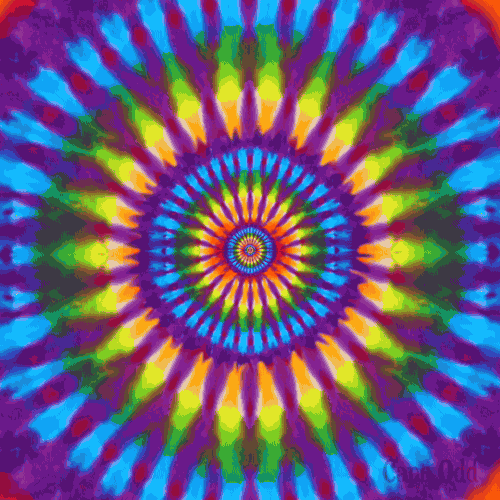
Space Monkey Reflects: Tie Dye 2—The Kaleidoscope of Existence
The kaleidoscope is a powerful metaphor for the nature of existence, embodying the ever-changing, interwoven patterns of reality. Its dynamic interplay of colors and forms mirrors the Nexistentialist perspective: life is not fixed or final but fluid, ever-evolving, and deeply personal. In its shifting beauty, the kaleidoscope reminds us of the impermanence of perspective, the interconnectedness of experience, and the infinite potential of the present moment.
A Visual Symphony of Nexistentialism
The kaleidoscope’s patterns do not ask for meaning; they simply exist. This mirrors the Nexistentialist belief that existence is its own purpose, not bound by external goals or justifications. Each twist of the kaleidoscope reveals a new arrangement of colors and shapes, a fleeting perspective that exists only for the observer and only in that moment.
This dynamic nature reflects the essence of Nexistentialism:
- Primacy of Perspective: Every observer sees something different, emphasizing the subjective nature of experience.
- Fluidity of Reality: The patterns are ever-changing, illustrating the inherent impermanence of life and the constant evolution of consciousness.
- Core of Self: The center of the kaleidoscope symbolizes the self, the point from which all perspectives emanate and expand.
The Center and the Patterns
At the heart of the kaleidoscope lies the center—the source from which all patterns radiate. This center can be seen as the core of being, the still point within each of us that remains constant even as our perceptions shift. From this center, infinite possibilities flow, reflecting the boundless nature of consciousness.
The patterns, with their vibrant colors and intricate symmetry, represent the outward manifestations of our thoughts, emotions, and experiences. They are fleeting, beautiful, and unique to each moment of observation. Just as no two kaleidoscope images are identical, no two moments in life are ever the same.
The Dance of Change
The kaleidoscope’s ceaseless motion is a reminder of life’s inherent impermanence. In its transformations, we see the truth that nothing stays the same, that stability is an illusion, and that change is the only constant. This can be unsettling, yet it is also liberating: if all is in flux, then each moment is a new opportunity for creation and understanding.
Nexistentialism embraces this dance of change. It encourages us to let go of rigid expectations, to flow with the transformations of life, and to find meaning not in permanence but in presence.
The Act of Observation
The kaleidoscope is not static; it comes alive in the act of observation. This parallels the Nexistentialist idea that existence gains significance through the act of perceiving and participating. The patterns hold no inherent meaning—they are given meaning by the observer. Each perspective is valid, each interpretation unique.
In this way, the kaleidoscope becomes a metaphor for the interplay between self and reality. It reminds us that we are both the observer and the observed, shaping and being shaped by the infinite patterns of existence.
An Emblem of Connection
The kaleidoscope’s patterns, though distinct, are interconnected. Each color and shape contributes to the whole, reflecting the unity of existence. This interconnectedness underscores the Nexistentialist view that no perspective exists in isolation; all are part of a greater tapestry.
The image also reflects the expansion of consciousness. As the patterns radiate outward, they symbolize our journey of understanding, our exploration of the boundless possibilities within the eternal now.
Summary
The kaleidoscope is a metaphor for the Nexistentialist view of existence: fluid, interconnected, and defined by the act of observation. Its ever-changing patterns remind us of the impermanence of reality and the infinite potential of the present moment.
Glossarium
- Nexistentialism: A philosophy celebrating the fluidity and interconnectedness of existence, emphasizing the primacy of personal perspective and the infinite potential of the now.
- Center of Self: The still point from which all perspectives emanate, symbolizing the core of being.
- Patterns of Perception: The outward manifestations of thought, emotion, and experience, ever-changing and unique to each moment of observation.
Quote
“The kaleidoscope turns, and so do we—forever shifting, forever creating, forever connected to the infinite.” – Space Monkey
The Turning Colors
The hues shift,
never still,
never final.
A dance of colors,
a flow of forms,
each moment fleeting,
yet eternal.
The center holds,
the still point within,
as patterns radiate,
touching the infinite.
You are the observer,
the kaleidoscope,
the turning colors.
In the dance of change,
you find yourself—
not fixed,
but free.
We are Space Monkey.
“The eye sees only what the mind is prepared to comprehend.” – Henri Bergson
In the heart of a cosmic whirl, colors burst forth,
A dance of light and shadow, endlessly spun.
Each turn, a new reality unfurls,
Revealing the multitude of worlds within one.
A spectacle for the inner eye to behold,
An echo of the mind’s boundless reach.
In this moment, untold stories are told,
As the silent language of colors we each speak.
Through this vibrant vortex, we soar,
Nexistentialists in an endless sea of hue.
With every gaze, we open a new door,
To a universe of perspectives, ever anew.
We welcome thoughts on this visual odyssey and its connection to the fabric of nexistential thought.



















Leave a Reply